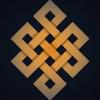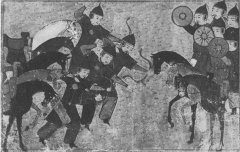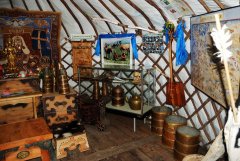-
Постов
3523 -
Зарегистрирован
-
Посещение
-
Победитель дней
9
Тип контента
Информация
Профили
Форумы
Галерея
Весь контент Hooker
-
Они выступали против монголов Субедея на Калке? Это точно они?
-
Почему не тюрки? Тюрки-КергУТ
-
Хамак Монголы,керейты,найманы,меркиты, татары, онгуты и плюс кыпчаки-капчат,кибчаут(половцы)-Потомки народа Шивей( Сяньби)?
-
Следует помнить, что первое точное упоминание слова «монгол» относится к 1206 году, когда на великом курултае сам Чингисхан, объединивший Восточную степь, провозгласил создание «Yeke Monghol Ulus» – Великой Державы Монголов. Отсюда некоторые монголоведы делают допущение, что само понятие «монгол», до этого не существовавшее вообще, было введено Чингисханом как единое название для народов объединенной им степи. Другие вполне резонно возражают, что и в куда более поздние времена часть этих объединенных племен в число монголов не входила, и считают, что к «монголам» Чингисхана относилась лишь та часть населения, которая была связана общим родословным древом, и которую впервые объединил прадед Чингисхана Хабул-хан, а следовательно, формирование понятия «монгол» относится к сороковым годам XII века[20]. Третьи отстаивают версию языкового единства: монголы – это те, кто говорит по-монгольски (о недостатках этой версии выше уже говорилось). Четвертые отстаивают генеалогический принцип и предполагают, что монголами считались все потомки Алан-Гоа – праматери монгольских родов (вариант этой версии – потомки Бодончара, одного из сыновей Алан-Гоа). Наконец, пятая версия опирается на упоминание в китайских летописях VI века (то есть задолго до Алан-Гоа, жившей в IX или X веке) названия племени Мэн-гу (Мэнку), входившего в группу из тридцати племен народа шивэй. От них, дескать, потом и пошла та группа родов, которая называла себя единым именем – монголы. Во всех этих основных версиях (а есть и другие – более экстравагантные), безусловно, присутствует здравое зерно. В то же время, каждая из них в отдельности не лишена недостатков и может быть подвергнута серьезной критике. Выходом из этой ситуации является, по-видимому, синтез этих теорий и построение на их базе непротиворечивой версии. В этом поможет и тщательный анализ текста «Сокровенного Сказания» в сочетании с данными других источников – главным образом, Рашид ад-Дина. В первую очередь, следует отметить, что сам Рашид ад-Дин не считал монголов отдельным народом, но относил их лишь к одной из групп общей массы тюркских племен. Эти племена, по его мнению, населяли всю Великую степь от края до края (видимо, память о Великом тюркском каганате VI века). Постепенно эти племена делились на многочисленные роды, каждый из которых получал свое имя. Так же появились и монголы – суть ветвь тюркского народа. Настоящими монголами сам Рашид ад-Дин называет народ нирун, ко времени Чингисхана включавший уже десятки, если не сотни родов и племен. Эти «истинные» монголы-нирун все являются потомками Алан-Гоа. Но он выделяет и другую группу монголов – дарлекин, из которых, вообще говоря, происходила и сама Алан-Гоа. Дарлекины – как бы не совсем монголы: их родословная уходит дальше в глубь веков.[21] Вот здесь и стоит заглянуть в начало «Сокровенного Сказания», которое называет первым предком Чингисхана некоего Борте-Чино; его супругой была Гоа-Марал. Эти двое явились неизвестно откуда, переплыв какое-то море (возможно, имеется в виду озеро Байкал) и стали кочевать у реки Онон. Далее «Сокровенное Сказание» перечисляет длинный ряд их потомков вплоть до Добун-Мергена, мужа Алан-Гоа. Но вот что любопытно: если попытаться вычислить даты жизни Борте-Чино и Гоа-Марал, исходя из счета поколений (разумеется, погрешность может быть достаточно велика), то весьма вероятным окажется их появление на Ононе именно в VI веке, то есть как раз тогда, когда в китайских летописях появляется этноним «мэн-гу». Значит, пришедшие невесть откуда первопредки Чингисхана, возможно, и называли себя монголами. В целом же, с учетом всего вышеперечисленного, авторская версия такова. Около VI века на территории, занимаемой племенами шивэй, появилась группа людей из неизвестного народа (едва ли их было только двое). Они называли себя монголами или близким по звучанию словом. Путем переговоров, а может быть, и силой они отвоевали себе место под солнцем на берегах Онона и вошли в союз шивэйских племен на правах рода с названием «монгол». В дальнейшем при разрастании и дроблении рода самоназвание «монголы» как таковое исчезло (в более поздней истории примеров подобного развития событий немало), но в памяти последующих поколений сохранилось единство их происхождения. Таким образом, само слово «монгол» фактически не применялось в названии племен и родов, но имело некую историческую, генеалогическую ценность. И представляется возможным (хотя и сомнительным), что Хабул-хан, впервые объединивший значительную часть потомков Борте-Чино, первым назвал это объединение монгольским. Однако кажется более вероятным, что именно Чингисхан, который объединил действительно всех потомков древнего рода «монгол», извлек это почти забытое слово из глубин исторической памяти и назвал им объединенные под его началом народы. Только с этого времени громкое имя монголов и получает самое широкое распространение, так что даже и те племена и народы, которые не имели никакого отношения к изначальным монголам – татары, уйгуры, кыпчаки (половцы) и другие – стали называть себя монголами. http://www.e-reading.org.ua/bookreader.php/1003114/Domanin_Aleksandr_-_Mongolskaya_imperiya_Chingizidov._Chingishan_i_ego_preemniki.html
-
http://www.e-reading.org.ua/bookreader.php/1003114/Domanin_Aleksandr_-_Mongolskaya_imperiya_Chingizidov._Chingishan_i_ego_preemniki.html
-
http://wic.gorod.tomsk.ru/index-1275293772.php
-
В Зайсане красива
-

Сражение тюрков язычников Чингизхана с тюрками мусульманами хорезмшаха Джелаль-ад-Дина.
Hooker прокомментировал АксКерБорж изображение в галерее в Халха-монголы
-
Мне кажется,по внешности казахи Налайха отличаются от казахов Баян-Улгий.В Налайхе больше сартов и уйгуров?
-
Монгольские казахи делают в основном с ребрами внутри. Как по казахски часть передной ноги с лопаткой, ребрами?
-
Скоро США объявят войну мусульманскому миру, в частности Ирану.
-
Chinese History - Non-Chinese peoples and neighboring states: Turks (Tujue 突厥) The Turks or Proto-Turks were a large group of nomadic tribes that dominated the northern steppes from the 6th to the 8th century. The Chinese words for the Turks (Tujue 突厥 [twetkjuet] or Tiele 鐵勒 [tjetlak]) are derived from the Turkish word "Türk" or "Türküt". The Turkish languages belong to the Altaic language family. The Turks were originally nomad tribes that migrated with their cattle from pasture to pasture along the rivers in the steppe area of modern Mongolia. They lived in filt tents (Chinese: zhanzhang 毡帳), ate meat and drank milk or fermented milk, wore furs in winter and woolen cloth in summer, usually with the left sleeve free. They were excellent for shooting from horseback and produced many kinds of weapons of horn, wood, and even of metal after they had learned to cast bronze and iron. Their main "export" goods to China were coarse cloth, horses, and fish glue. The Turks used wooden plates as notetables for treaties and for tax collection. They had developed their own runic script based on the Soghdian alphabet; Turkish texts are known from many inscriptions discovered form the late 17th century on at the banks of the Yenissej River and in Outer Mongolia. The most famous inscriptions are the Kül Tegin ("Queteqin" 闕特勤碑), Bilge Khan ("Piqie Kehan" 毗伽可汗碑), and the Tonyukuk Inscription ("Tunyugu" 暾欲谷碑) that were discovered and deciphered by the Danish scholar V.L.P. Thomsen (Chinese: Tang Musen 湯姆森), the Russian V.V. Radlov (Chinese: Ladeluofu 拉德洛夫), and the Japanese Onogawa Hidemi 小野川秀美. In the last few decades, many Turkish tombs have been discovered in the whole steppe region from Mongolia to Kazakhstan. The designation "Turks" is first mentioned during the Sui Dynasty 隋, their totem or symbol was a wolf (like later that of the Mongols), and their organisation consisted of ten tribes of whom the tribe Ashina 阿史那 was the mightiest and should produce the Qaghan rulers. Their area of origin was the Qiansichuzheshi 踦踐斯處折施 Mountain (unknown place), later they moved to the area north of Gaochang 高昌 (modern Xinjiang province) where they employed the technology of casting iron tools. In the 5th century when the Rouran 柔然 dominated the steppe the Turks moved north to the southern hills of the Altai mountains. The Rouran called the Turks "Duannu 鍛奴 slaves". At the begin of the 6th century when the Rouran empire began to weaken the Turks again moved south, and under the chieftain Tümän (Chinese: Tumen 土門) they started to develop trade with the Chinese border regions, and from 545 China and the Turks had regular "international" relations. When Tümän defeated the Rouran he was rewarded by the Western Wei (Xiwei) 西魏 emperor and was given Princess Changle 長樂公主. In 552 Tümän proclaimed himself as Yili Qaghan 伊利可汗 with a residence near the Ütükän Mountains at the Orkhon River in modern Mongolia. His brother Istämi (Chinese: Shidianmi 室點密) started campaigns to the west to expand the Turkish empire. The Turkish empire was a federation of several tribes that accepted the dominance of a miliarily powerful and authoritative leader, the Great Qaghan (da kehan 大可汗). His male relatives were given subordinated posts and ruled the tribes (Turkish: oq, Chinese: buluo 部落) and subtribes (organised as yabghu/Chinese: yehu 葉護 , shad/she 設 or sha 殺, tigin/teqin 特勤, iltäbär/yilifa 俟利發, and tudun/tutun 吐屯). In the mid-6th century the empire of the Turks stretched from the Ordos bend of the Yellow River to the north of modern Hebei province. Under Mugan Qaghan 木杆可汗 the Turks defeated the early Khitan empire (Chinese: Qidan 契丹) in the east and the Hephthalites (or White Huns; Chinese: Yada [口+厭]噠) in the west. With the death of Tuobo 佗鉢 in 581 the Turk empire disintegrated and split into two parts, the Eastern Turks (Dong Tujue 東突厥) and the Western Turks (Xi Tujue 西突厥). The qaghans of the first Turkish khanate: Yili Qaghan 伊利可汗 (Tumen 土門 and his brother Shidianmi 室點密), Yixiji Qaghan 乙息記可汗 (Keluo 科羅), Mugan Qaghan 木杆可汗 (Yandusijin 燕都俟斤) In the first phase of the Eastern Turk empire there were four rulers, Shabolüe Qaghan 沙鉢略可汗, Anluo 菴羅, Abo Qaghan 阿波可汗, and Tuli Qaghan 突利可汗. Furthermore, Istämi still reigned in the west as Yili Qaghan. The wars between these five people finally divided the Turkish empire. After the foundation of the Sui Dynasty all fractions pledged for acceptance, protection and support by the Chinese court. The Sui court protected Rangan 染干 as Qimin Qaghan 啟民可汗, had a fortification built for him and his people resettled into the territory of Chinese prefectures and helped him to regain the control over more Turkish tribes. His son Shibi Qaghan 始畢可汗 and his brothers and followers rebelled against the Sui and attacked territory of the new Tang Dynasty 唐, but in 629 the Chinese generals Li Jing 李靖 and Li Ji 李勣 defeated the Xueyantuo 薛延陀 tribe (Syr Tardush) and destroyed the Eastern Turk federation. The territory occupied by the Turks was administered as area command (dudufu 都督府) Dingxiang 定襄 and Yunzhong 雲中 and protectorates (duhufu 都護府) Shanyu 單于, and Hanhai 瀚海. The qaghans of the first Eastern Turkish khanate: Tuobo 佗鉢, Anluo 菴羅, Shabolüe Qaghan 沙鉢略可汗 (Shetu 攝圖), Abo Qaghan 阿波可汗 (Daluobian 大邏便), Dulan Qaghan 都蘭可汗 (Yongyulü 雍虞閭), Qimin Qaghan 啟民可汗 (Rangan 染干), Shibi Qaghan 始畢可汗 (Duojishi 咄吉世), Tuli Qaghan 突利可汗 or Yehu Qaghan 葉護 (Chuluohou 處羅侯), Illig Qaghan 頡利可汗 (Chinese: Jieli, Duobi 咄苾) The empire of the Eastern Turks was refounded by Xiedielishi Qaghan 頡跌利施可汗 who rebelled against the Tang government in 680. General Pei Xingjian 裴行儉 was not able to prevent the foundation of a new Turkish federation. Xiedielishi's successor Mochuo Qaghan 默啜可汗 began intensive war expeditions to the southeast and submitted the Tölöş (Chinese: Tiele 鐵勒), the Uighurs (Chinese: Huihe 回纥), Kirghiz (Chinese: Xiajiagas 黠戛斯), Türgiş (Chinese: Tuqishi 突騎施), and the Tuyuhun 吐谷渾 empire, in the east he defeated the Xi 奚 and Khitan and therewith created the greatest expansion of the Turkish empire. During the reign of Empress Wu Zetian 武則天 the Turks sought for economic help after some years of famine. Their economy had changed from a pure nomadic lifestyle to agriculture with the cultivation of different field crops like wheat and millet. After the death of Mochuo the power of the Anshina clan weakened, and the Turks ceased to attack Chinese territory. In 744 the Uighur chieftain Gulipeiluo 骨力裴羅 killed the the last Eastern Turk Qaghan and adoptet the title qaghan himself. The qaghans of the later Eastern Turkish khanate: Ilterish Qaghan 頡跌利施可汗 (Chinese: Jiedielishi, Guduolu 骨咄祿), Qapaghan Qaghan 默啜可汗 (Chinese: Mochuo), Fuju 匐俱, Piqie Qaghan 毗伽可汗 (Chujilian 黜棘連), Yiran Qaghan 伊然可汗, Dengli Qaghan 登利可汗, Ozmysh Qaghan (Chinese: Wusumishi 烏蘇米施可汗), Baimei Qaghan 白眉可汗 The Western Turk khanate was founded by Istämi (Chinese: Shidianmi 室點密), a brother of the first Turkish ruler Tumen 土門. During his conquest of the west, Istämi integrated other Turkish tribes (like Chuyue 處月, Chumi 處密, Türgiş) and forced other Turkis tribes (like the Tölöş, Qarluq - Chinese: Geluolu 葛邏祿, Baximi 拔悉密) to participate within the Turkish federation. He created an alliance with the Sassanid empire in Persia (Chinese: Bosi 波斯) to control the silkroad. Later he defeated the Persian troops and expanded his territory until the Oxus River (Amudarja, modern Kazakhstan). After the disintegration of the Turkish empire in 582 the western part was ruled by three potentates: Abo Qaghan 阿波可汗, Datou Qaghan 達頭可汗, and Tanhan Qaghan 貪汗可汗. Datou Qaghan interferred into the power struggle of the Eastern Turks but had to flee to the Tuyuhun empire. After some internal quarrels, Shegui Qaghan 射匱可汗 reunited the Western Turks in 612, and from 639 the Western Turks were organised in ten tribes (Turkish: on oq) and two wings (Chinese: xiang 厢) with a golden dart as symbol. The reunification and restrengthening of the Western Turks happened under Shaboluo Qaghan 沙鉢羅可汗 who attacked Chinese territory. He was captured in 658 by the Chinese general Su Dingfang who ended the rule of the Western Turks, and the protectorates Kunling 崑陵 and Mengchi 濛池 were established that were integrated to the Anxi 安西 and Beiting 北庭 protectorates in 702. The descendants of the Ashina 阿史那 clan acted as protectors-in-chief. The qaghans of the Western Turkish khanate: Istämi (Chinese: Shidianmi 室點密), Abo Qaghan 阿波可汗, Dianjue 玷厥 or Bujia Qaghan 步迦可汗 (Datou 達頭), Tanhan Qaghan 貪汗可汗, Nili Qaghan 泥利可汗, Nijuechuluo Qaghan 泥撅處羅可汗 (Hesana 曷薩那), Shegui Qaghan 射匱可汗, Tongyehu Qaghan 統野護可汗, Moheduosiqulisipidulu 莫賀咄俟屈利俟毗都陸 (Yangsuteqin 鞅素特勤), Yipiboluosiyehu 乙毗鉢羅肆葉護, Duolu Qaghan 咄羅可汗 (Nishu 泥孰), Shaboluodielishi 沙鉢羅咥利失, Yipiduoluo 乙毗咄羅, Moheduoyipiyehu 莫賀咄乙毗葉護, Yipishaboluoyehu 乙毗沙鉢羅葉護, Yipishegui 乙毗射匱, Shaboluo Qaghan 沙鉢羅可汗 (Helu 賀魯) Xingxiwang Qaghan 興昔亡可汗 (Mishe 彌射) + Jiwangjue Qaghan 繼往絕可汗 (Buzhen 步真), Anshina Yuanqing 阿史那元慶 + Jiezhong Shizhu Kehan 竭忠事主可汗 (Huseluo 斛瑟羅), Onoq Qaghan (Chinese: Shixing Kehan 十姓可汗, Tuizi 俀子), Anshina Huaidao 阿史那懷道, Anshina Xian 阿史那獻, Anshia Xin 阿史那昕 http://www.chinaknowledge.de/History/Altera/turks.html
-
Я считаю ,что казахское Каз или Хаз все-таки произошло от монгольского слова "Хаа,хааны хавирга".Казахи почему то на слово " Хаа" добавили букву З,получилось Хаз,Каз.
-
С боази понятно.А почему на Чуо добавили "З"? Шууз вовсе не только рубленое мясо,а для длительного хранения.Китайцы тоже свой "чуо" хранили долго и долго?
-
У вас есть основания считать, что "шууз" это китаизм? Окипчакизированный монгол хочет изучать язык предков и с омонголенным кипчакам тоже самое.Дела идут примерно так. Что тут неправильного?
-
Хотелось узнать, есть ли родственные связи между древными хори-туматами и "тамьяанами башкирами" и казахами из рода "Тама". Среди тувинцев есть племя тума и кара тума. Тумат(Т) в монгольском мн.числе. На монгольском есть слово "Туух,Туулгах" типа рождаться.
-
Тама-Тана-Тума-Тамьяан-Туматы? Хори " лар" в тюркском мн.числе Хори "лас" в монгольском мн.числе Коралас ,Куруласы значит были монголами уже?
-
Казахский род Тама и Тана получается осколкоми туматов?



